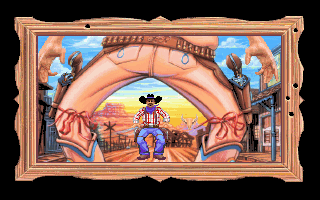I first played this game when I was a youngling at my Uncle’s house and I remember being so excited when I booted it up and watched the witty Ballad of Freddy Pharkas play out.
The concept was original and captivating—an ex-gunslinger hangs up his sidearms to go out West and become a pharmacist before events draw him back in to his gun-toting ways—all set in a gorgeous cartoon Wild West setting.
I quickly filled the first two prescriptions that acted as the copy protection to the game, then enthusiastically took Freddy outside to explore where I promptly walked into a swamp and died.
Tombstone
Like the real Wild West, the environment is harsh and unforgiving and rewards a more careful style of play where everything is treated as a potential threat. “How can this kill me” is a question that should be front and centre for most of the game.
If you enjoy Sierra’s style of often amusing deaths, then this game will not disappoint. It says in the puzzle document that it has 44 unique ways to shuffle off this mortal coil.
I’m more of a happy-go-lucky, click everywhere, use everything kind of adventure gamer so this approach often had me leading Freddy to an early end.
Unfortunately, I have also been forged in the fire of casual mobile gaming. I have become habituated to ubiquitous auto-save, forgetting that back in the early 90s games did not employ this as a matter of course.
As you can imagine, these two traits repeatedly led to significant loss of progress and accompanying salty outbursts.
Blazing Saddles

As we move haltingly towards more equality and understanding it’s getting harder to find any cultural artefact from more than 20 years ago that isn’t problematic in some way.
While this shouldn’t diminish any nostalgia we might have for our cultural history, it is important that we at least acknowledge the problems.
In this case, the game is well voice-acted but it is another example of white people voicing other races in that played-for-laughs but now intensely cringeworthy way of the 80s and 90s. The Chinese character, Hopalong Singh, is a particularly egregious example of stereotyping for yucks, although the Native American and Indian characters don’t fare much better.
The rest of the comedy in the game runs the gamut from the scatalogical (one puzzle involves collecting horse farts, another fixing the town’s diarrhoea problem) to the intellectual. There are subtle jokes mixed in with the more bawdy laughs and the pharmacy guide in particular has a wide variety of interesting ailments and cures (“Doctor’s Best Guess” is a particular favourite of mine).
3:10 to Yuma
The narrative itself is constructed more as a series of vignettes which are related to a slowly unfolding nefarious plot that stays way in the background for most of the game before suddenly coming front and centre in the dramatic final act.
The story is cleverly designed to have you solving a bunch of weird and seemingly unrelated problems that are then nicely tied together with a twist at the end.
Personally, I would have liked to have seen this game employ that famous dramatic device known as Chekov’s Pharmacy Cabinet where, right at the last minute, Freddy’s gunslingin’ gives way to his Pharmacistin’ and, like in Monkey Island 2, the skills of mixing magic medicines that I learned at the start of the game would turn out to be what I really needed to save the day.
It would complete the classic narrative circle, bringing me back to where I started having changed significantly and it turns out the journey was all about the Friends I Learned Along The Way.
A Fistful of Dollars
The puzzle progression is strictly linear which doesn’t gel super well with my scatterbrained thinking and aforementioned scattershot exploring. I enjoy having many different problems to tackle at the same time and, without the option of parallel puzzles, I found myself getting stuck in this game on the regular.
These puzzles give way to action in the last act, which sees Freddy getting involved in a whole lot of gunfightin’. These sequences require a modicum of reaction skill, although by this point I had been trained by my faithful sidekick and I had the option to make it easier if I wanted.

I chose the hard route but, as the act progresses, the punishment for failing becomes more and more severe as the opportunities to save my progress during these action sequences were few and far between.
I think that action game sections in adventure games should either be optional diversions or the requirements should be so low as to basically make them impossible to fail (why did I choose the hard route, then? Sadly, even the hint of a game calling me chicken and I instantly become Marty McFly).
Anyway, if you enjoy having your mouse hand reaction speeds tested in the midst of your exploring, then you’re in luck. Just save when you can.
For A Few Dollars More?
I so desperately wanted to love this game because it ticks so many of my adventurin’ aesthetic boxes: an interesting premise, well-rendered cartoony graphics, irreverent humour, and a fully-realised world.
Unfortunately, the linearity, the endless narration, the constant deaths, and the action game ending outweighed these strengths and I found myself getting frustrated often (admittedly, much of this frustration came down to me forgetting that these games won’t save themselves). While I appreciate much of what this game sets out to do, it doesn’t do it for me.
However, if either the Sierra style of adventure game or the Old West cartoon aesthetic appeals to you, then there is still a lot to love in this 25 year old game.
Major Lesson: Check the guns at the door.
